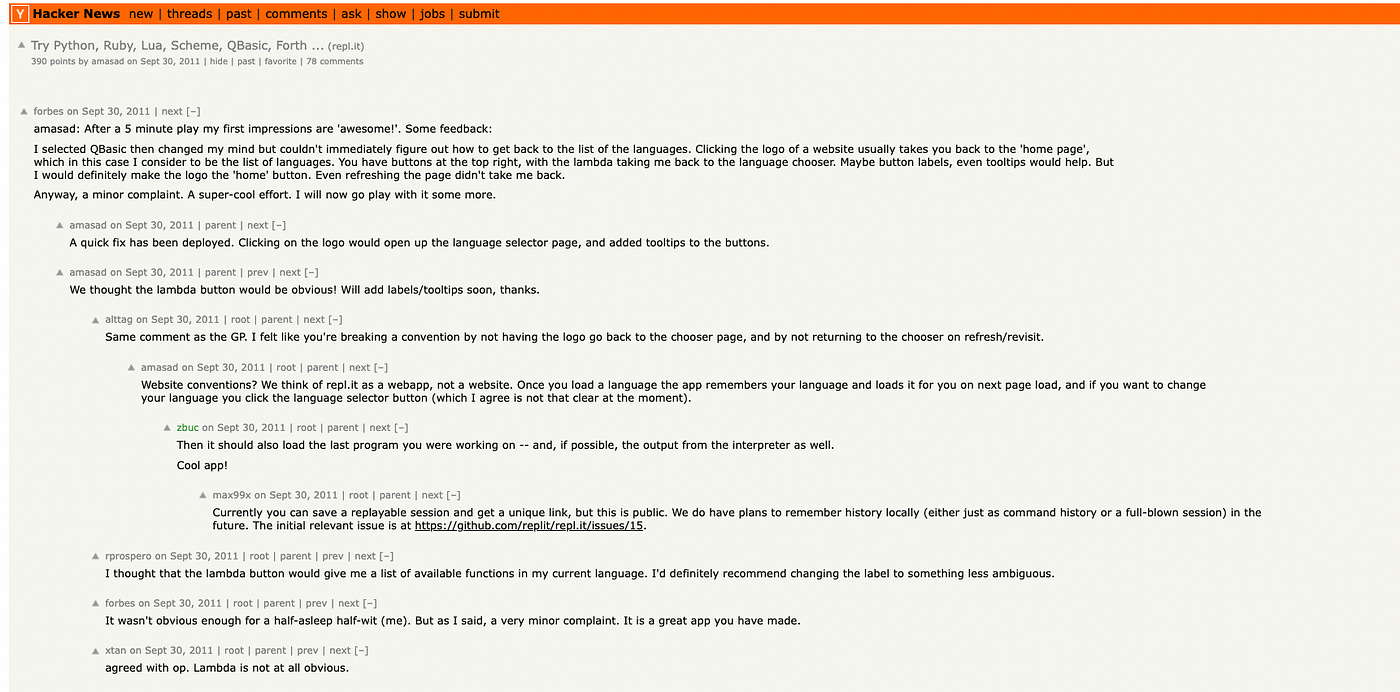DevTools Brew #31: Replit’s Journey: From College Side Project to $800M Tech Giant, Why Product-Led Sales Works for Dev-First Companies...
Hey folks, welcome to DevTools Brew #31!
We did it!!! 🔥 We just crossed the 1k subscribers mark for Devtools Brew, and it's all thanks to your incredible support. Your engagement means the world to me 🙏
As a bonus, I'll share my journey from 0 to 1k subscribers in 7 months at the end of this newsletter.
And if you're new here, my name is Morgan Perry, co-founder of Qovery, and every Saturday, I share the stories, strategies, and insights behind the most successful devtool companies.
In this Issue #31:
📈 Replit’s Journey: From College Side Project to $800M Tech Giant
💻 Why Product-Led Sales Works for Dev-First Companies
⭐ Star History Weekly Pick
💰 Devtools Funding Rounds of The Week
🍿 Bonus: Lessons from 0 to 1k Subscribers (Devtools Brew)
I hope you will enjoy this new edition.
Let's dive in!
📈 Replit’s Journey: From College Side Project to $800M Tech Giant
Excited today to share an inspiring journey from a humble college side project to witnessing the meteoric rise of Replit, now an $800 million tech giant. Let's explore how Amjad Masad's determination transformed this coding platform into a remarkable success story 👇
Key Takeaways
The Genesis: From Internet Cafes to Replit
Amjad's formative years in Jordan, where coding meant visits to internet cafes.
The "Aha!" moment was sparked by Google Docs, driving the vision of a collaborative coding environment.
Collaboration with classmates Max and Haya in 2009 to bring this vision to life.
Open-Source Emergence on HackerNews
The relentless pursuit of their dream project, Replit.
The pivotal moment was when Replit debuted on HackerNews, catching the attention of tech enthusiasts.
Rapid recognition as one of the top posts for the day, signaling the platform's potential.
Codecademy Connection
The fateful encounter with Zach Sims and Ryan Bubinski, founders of Codecademy.
Codecademy's discovery of Replit on GitHub, identifying its synergy with their startup.
The personal invitation to Amjad to join Codecademy strengthened Replit's ties to the coding education sphere.
The Facebook Interlude
Amjad's transition to Facebook and involvement in the internet.org initiative.
Amjad's persistent vision of a startup akin to Replit driven by a passion for accessible coding.
Initial hesitance to take on the CEO role was rooted in the challenges observed during his time at Codecademy.
Multiple Rejections and Y Combinator
The uphill battle: Y Combinator's initial skepticism towards Replit's potential.
Amjad's relentless efforts to secure a full-time CEO and funding for Replit's growth.
The turning point: Co-founder Haya's unwavering conviction, motivating Amjad to pursue Replit full-time.
The Pivot to Education
Replit's strategic shift towards the education sector in 2017.
The launch of "Classrooms" (now Teams for Education) revolutionizing computer science teaching.
Rapid success, exemplified by $150,000 in sales and the organic growth of their user base.
Y Combinator Acceptance and Growth
The pivotal moment of acceptance into Y Combinator's W18 cohort.
Raising $4.5 million in seed funding, enabling Replit's expansion.
Impressive user growth, culminating in 5 million users by the end of 2020.
Replit's Recipe for Success
The core ingredients: A superior product, viral features, and strategic promotion.
The resonance on platforms like HackerNews, contributing to Replit's visibility.
Strong adoption among educators and students, empowering the next generation of coders.
Building a Global Learning Platform
Replit's unwavering commitment to coding education.
The incentivization of learning through bounties and the development of community-driven features.
A platform nurturing coding enthusiasts worldwide.
Amjad Masad's journey from a young coder in Jordan to a global tech entrepreneur is truly inspiring. Replit's mission is clear: to empower learners, educators, and developers worldwide through accessible coding education. Amjad's journey exemplifies this mission, showcasing how technology can break down barriers and open doors to a world of opportunities.
—> To explore more, read the full article here - published by Louis Chen
💻 Why Product-Led Sales Works for Dev-First Companies
Selling to developers has its unique challenges. Developers often have less patience with traditional sales approaches. The concept of the Product-Led Sales is proving to be a game-changer for companies, even beyond the Developer Tools space. Let's dive into the key insights👇
Key Takeaways:
Why Product-Led Sales Matters for Dev-First Companies
1. End User Engagement
Product-Led Sales relies on having users actively try and use your software. Developers love experimenting with new tech, and this hands-on experience builds belief in your product far better than traditional sales demos.
2. Smart Outreach
With active SaaS product usage, your team gains insights into user habits and challenges. This data is gold for targeted outreach that developers and their managers appreciate.
3. Massive Customer Base
In businesses with strong self-service customer bases, you can grow a substantial customer base within key accounts before introducing product-led sales. This strategy maximizes your reach.
4. Easier Conversations
When it's time to pitch, you don't need to convince developers directly. Instead, reach out to their bosses – senior decision-makers with bigger budgets and a willingness to solve significant problems. Having existing product adoption among their team makes these conversations smoother.
Preparing for a Product-Led Sales Motion
1. Start Simple
Begin with a "crawl" stage. Keep it simple but intentional. Perfection isn't necessary; learning is the goal.
2. Data Accessibility
Provide your team with easy access to relevant data. A data warehouse and tools like Amplitude or Mixpanel can help interpret data trends.
3. Ideal Customer Profile
Understand the common traits of users who buy your software. This doesn't have to be perfect, but provides valuable insights.
4. Identify Product Signals
Go beyond basic metrics like clicks. Dig into the customer journey, looking for key touchpoints indicating buying intent.
5. Prioritize Leads
Develop a prioritization approach based on the above criteria. This helps your teams sort through potential leads effectively.
The Product Led Sales approach is transforming how companies engage developers and grow their businesses. It's a tactic that's rapidly gaining traction, driven by the strong signal of intent that product usage provides. As you embark on this journey, remember to start simple, leverage accessible data, and prioritize your efforts.
—> To explore more, read the full article “Why Dev-First loves Product Led Growth (Sales)?” - published by Francesca Krihely
⭐ Star History Weekly Pick
The Star History Weekly Pick is:
Wasp: “The fastest way to develop full-stack web apps with React & Node.js”
⭐️ 6k stars reached
💰 Devtools Funding Rounds of The Week
Pulumi, the leading open-source Infrastructure as Code platform, announced $41M in Series C funding.
Opsera, a DevOps platform geared toward enterprise clients, raised $12M in a funding round.
Kestra, an open-source data orchestration platform for complex workflows has raised $3M in a seed round.
PerfectScale, the RTP software startup raised $7.1M in Seed funding to bring an AI-driven solution that autonomously and continuously optimizes each layer of the Kubernetes stack.
Beecrowd announced having raised $1M in Seed funding to build the largest community of developers in LATAM.
Helio, a carbon-aware cloud computing raised $5M in a Seed round from QBIT Capital.
Gradient, a startup that allows developers to build and customize AI apps in the cloud using large language models (LLMs), emerged from stealth with $10M in funding.
Observe, which develops software-as-a-service observability tools for storing, managing and analyzing machine-generated data and logs, raised $50M in convertible debt.
🍿 Bonus: Lessons from 0 to 1k Subscribers (Devtools Brew)
Reaching 1k+ subscribers on my newsletter was a milestone that took me 7 months 🥵
What's even more fascinating is how the growth went from a crawl to a sprint.
Here are my key takeaways
1. The 6-Month Hurdle
It took me 6 months to gain just 500 subscribers... and only 1 month to get the other new 500 subscribers!
The turning point came after the 25th edition of my newsletter... yes!
2. The 3C Rule. Consistency. Consistency. Consistency
The one constant in my journey was consistency.
Regularly delivering content played a pivotal role in building trust and anticipation.
Consistency is the cornerstone of your growth.
3. Niche and Editorial Focus
In the early days, my content was broad and unfocused.
It took time (and a dozen articles) to define my niche.
4. The 50/50 Rule: Creation (50%) - Promotion (50%)
While content creation is important, don't underestimate promotion and distribution.
Balancing both aspects is crucial for growth.
Even with limited time, I try to dedicate efforts to get the word out (but still not enough)
5. Audience Connection
⬪ Building a strong connection with your audience is vital.
⬪ I actively sought feedback and preferences from my subscribers.
⬪ This engagement fostered a sense of community and boosted sharing.
Consistency, niche focus, and engagement with your audience are the real keys to making it.
Reaching 1,000 subscribers might seem like a modest milestone, but it's not just about the goal but the lessons learned along the way that truly matters.
So, whether your aim is 1,000 or 1,000,000 subscribers, hopefully, these strategies can propel you forward in your own unique journey.
And if you want to help me reach the next milestone of 10k subscribers, you can share Devtools Brew with your friends :)
It’s already over! If you have any comments or feedback, you can reach out to me on LinkedIn or Twitter.
Thanks for reading,
Morgan
There are no ads in my newsletter. All I ask is you subscribe, share, and enjoy! :)










Nice Morgan ! What a milestone! I am really impressed